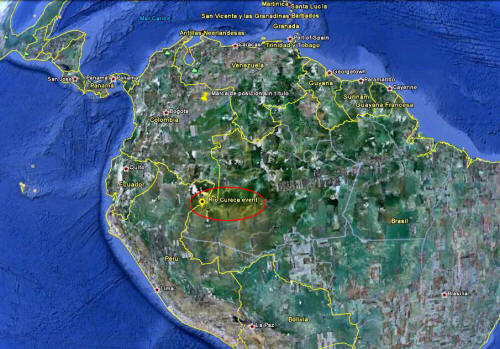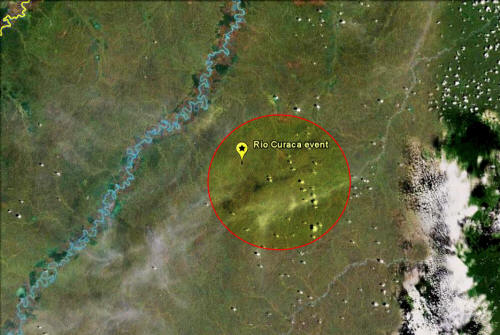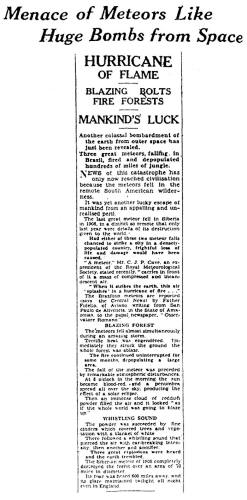|

by Duncan Steel
December 1995
from
XTEC Website
Spanish version
|
This article was
printed in IMO's
December 1995
edition of the WGN Journal.
It was written by Duncan Steel
of the
Anglo-Australian Observatory. |
There is evidence that there were two massive bolide explosions
which occurred over South America in the 1930's.
One seems to have
occurred over Amazonia, near the Brazil-Peru border, on August 13,
1930, whilst the other was over British Guyana on December 11, 1935.
It is noted that these dates coincide with the peaks of
the Perseids
and
the Geminids, although any association with those meteor showers
is very tentative.
The identification of such events is significant
in particular in that they point to the need for re-assessment of
the frequency of Tunguska-type atmospheric detonations.
1 - The Rio Curaca
event
In 1989 an article by N.Vasilyev and G.V. Andreev in the IMO Journal
(1) drew attention to a discussion, published in 1931 by L.A. Kulik
(2), of a possible Brazilian counterpart to the
Tunguska bolide
explosion of 1908.
The Brazilian event, which occurred on August 13,
1930, was described in the papal newspaper L'Osservatore Romano, the
report being derived from Catholic missionaries working in Amazonia.
That report, in Italian, was used as the basis of a front-page story
in the London newspaper The Daily Herald (since closed down), which
was published on March 6, 1931, and then seen by Kulik. (For the
interested reader, a copy of the story is reprinted in the December
1995 Journal).
The locality of the explosion gives it it's name:
The Rio Curaca
event.
This is close to the border between Brazil and Peru, at
Latitude: 5 degrees South, Longitude: 71.5 degrees West.


Both of these newspaper stories were discussed in a recent paper by
Bailey and co-workers (3), who provide an English translation of the
story which appeared in L'Osservatore Romano.
Since that paper
should be accessible to many readers of
WGN, I will not give an
extensive account of it here.
I will, however, just mention that
although the eye-witness accounts give do cover the phenomena which
one might expect to be produced by a massive bolide, there are some
other interesting reported observation which would require some
explanation. These include the following:
An ear-piercing "whistling" sound, which might be understood as
being a manifestation of the electrophonic phenomena which have been
discussed in WGN over the past few years.
The sun appearing to be "blood-red" before the explosion. I note
that the event occurred at about 8h local time, so that the bolide
probably came from the sunward side of the earth. If the object were
spawning dust and meteoroids - that is, it was cometary in
nature - then, since low-inclination, eccentric orbits produce radiants close to the sun, it might be that the solar coloration
(which, in this explanation, would have been witnessed elsewhere)
was due to such dust in the line of sight to the sun. In short, the
earth was within the tail of the small comet, if this explanation is
correct.
There was a fall of fine ash prior to the explosion, which covered
the surrounding vegetation with a blanket of white: I am at a loss
with regard to this, if the observation is correct (and not mis-remembered
as being prior-, rather than post-impact).
Bailey et al. also discuss the fact that the Rio Curaca event
occurred on the day of the peak of the annual Perseid meteor shower,
but conclude that this is likely to be purely a coincidence. The
date is also close to august 10, on which day in 1972 a large bolide
was filmed skipping through the upper atmosphere above western
Wyoming and Montana, departing from the earth above Canada (4).
Again, this may be merely a coincidence.
A brief discussion of the event is also given by R. Gorelli in
august 1995 issue of Meteorite! magazine.

2 - The Rupununi
event
I now move on to the suspected explosion over British Guyana in
1935.
The main source for information on this event is a story
entitled Tornado or Meteor Crash? in the magazine The Sky (the
forerunner of Sky and Telescope) of September 1939.(5)
A report from
Serge A. Korff of the Bartol Research Foundation, Franklin Institute
(Delaware, USA) was printed, he having been in the area - the
Rupununi region of British Guyana - a couple of months later. The
date of the explosion appears to have been December 11, 1935, at
about 21h local time. I might note that this is near the date of the
peak of the Geminid meteor shower, but yet again this may be merely
a coincidence.
The location is given as being near Lat: 2 deg 10min
North, Long: 59 deg 10 min West, close to
Marudi Mountain.
Korff's description suggested that the region of devastation might
be greater than that involved in the Tunguska event itself. On his
suggestion, a message was sent to William H. Holden, who in 1937 was
in the general region with the Terry-Holden expedition of the
American Museum of Natural History. That group hiked to the top of
Marudi Mountain in 1937 November and reported seeing an area some
miles across where the trees had been broken off about 25 feet above
their bases, although regrowth over two years in this tropical
jungle had made it difficult to define the area affected.
Holden
confirmed, on returning to New York, that he believed the
devastation was due to an atmospheric explosion of cosmic origin.
An
explorer and author, Desmond Holdridge, also visited the region in
the late 1930's and confirmed the suspicion that a comet or asteroid
detonation was responsible.
Korff obtained several local reports, the best being from a Scottish
gold miner, Godfrey Davidson, who reported having been woken by the
explosion, with pots and pans being dislodged in his kitchen, and
seeing a luminous residual trail in the sky.
A short while later,
whilst prospecting, he cam across a devastated region of the jungle
he estimated to be about five by ten miles (8 by 16 kilometers),
with the trees all seeming to have been pushed over.
Holden was unsure of the origin of the flattening of the forest, and
pointed out that similar destruction can result from tornados.
Holdridge, however, reported eye-witness accounts in accord with a
large meteoroid/small asteroid entry, with a body passing overhead
accompanied by a terrific roar (presumably electrophonic effects),
later concussions, and the sky being lit up like daylight.
A local
aircraft operator, Art Williams, reported seeing an area of forest
more than twenty miles (32 kilometers) in extent which had been
destroyed, and he later stated that the shattered jungle was
elongated rather than circular, as occurred at Tunguska and would be
expected from the air blast caused by an object entering away from
the vertical (the most likely entry angle for all cosmic projectiles
is 45 degrees).
There is a report of the Guyanan event, largely derived from the
account in The Sky, in the newsletter Meteor News for March 1974.
Apparently as a result of that, the publishers (Karl and Wanda
Simmons, of Callahan, Florida) had some correspondence with a Mr. F.A. Liems of Paramaribo, Surinam, concerning a possible
crater/event at Wahyombo in that country; he gives the location as
Lat: 5.25 deg North, Long: 56.05 deg West. The letters date from
1976; apparently Liems died in 1982.
In 1990, as a result of
Andreev's article in WGN about the Brazilian event, Wanda Simmons
sent copies to him, and he kindly sent copies on to me.
Various
notes/maps/letters are included, but it is difficult to know what to
make of them: my impression is that this concerns something that
occurred some time ago, not in this century, and it's linkage with
an incursion by an asteroid or comet is far from clear.
References
1) N. Vasilyev, G. Andreev, WGN
17:6, 1989, pp. 247-248.
2) L.A. Kulik, Priroda i Ljudi 13-14, 1931, p.6
3) M.E. Bailey, D.J.Markham, S. Massai, J.E. Scriven, The
Observatory 115, 1995, pp. 250-253.
4) Sky and Telescope 44, 1972, pp. 269-272.
5) The Sky, September 1939, pp. 8-10 and p.24.
Below is the wording of the Newspaper article printed in The
Daily Herald on March 6, 1931.
Another colossal bombardment of
the earth from outer-space has just been revealed.
Three great meteors, falling in Brazil, fired and
depopulated hundreds of miles of jungle.
News of this catastrophe has only now reached civilization
because the meteors fell in the remote S. American
wilderness.
It was yet another lucky escape of mankind from an appalling
and unrealized peril.
The last great meteor fell in Siberia in 1908. In a district
so remote that only last year were details of it's
destruction given to the world. Had either of these two
meteor falls chanced to strike a city in a densely populated
country, frightful loss of life and damage would have been
caused.
"A Meteor", Mr. C.J.P. Cave an ex-president of the
Royal meteorological Society stated recently "carries in
front of it a mass of compressed and incandescent air.
When it strikes the earth, this air "splashes" in a
hurricane of fire...
The Brazilian meteors are reported (says
the Central News) by Father Fidello of Aviano. writing from
San Paulo de Alivencia in the state of Amazonas, to the
papal newspaper, 'L'Osservatore Romano'."
BLAZING FOREST
The meteors fell almost
simultaneously during an amazing storm. Terrific heat was
engendered. Immediately they struck the ground the whole
forest was ablaze.
The fire continued uninterrupted for some months,
depopulating a large area. The fall of the meteor was
preceded by remarkable atmospheric disturbances. At 8
o'clock in the morning the sun became blood-red and a
penumbra spread all over the sky, producing the effect of a
solar eclipse.
Then an immense cloud of reddish powder
filled the air and it looked as if the whole world was going
to blaze up.
WHISTLING SOUND
The powder was succeeded by fine
cinders which covered trees and vegetation with a blanket of
white. There followed a whistling sound that pierced the air
with car-breaking intensity, then another and another.
Three great explosions were heard and the earth trembled.
The Siberian meteor of 1908 completely destroyed the forest
over an area of 70 miles in diameter.
It's roar was heard
600 miles away and it's glare maintained twilight all night
even in England.
|



